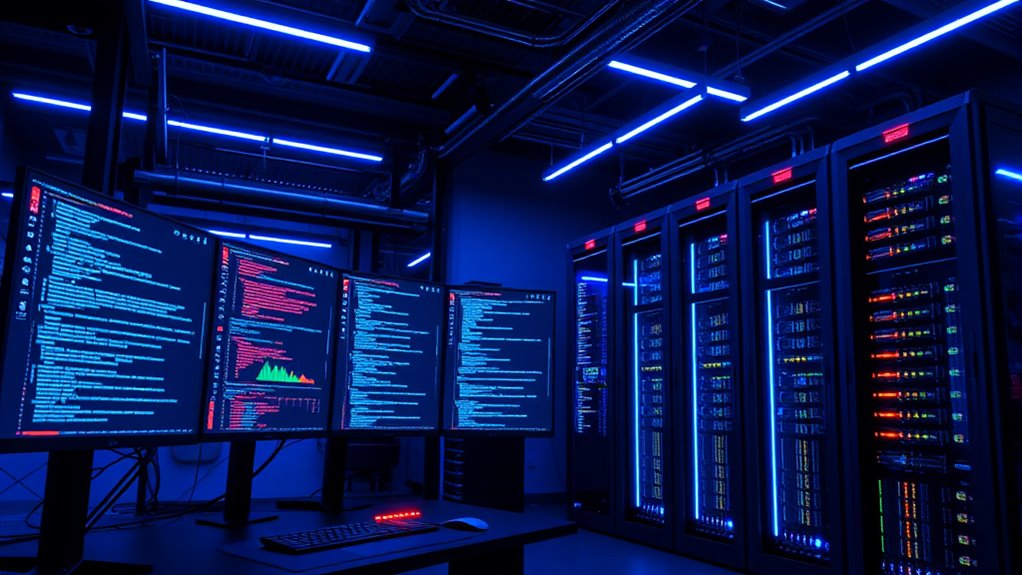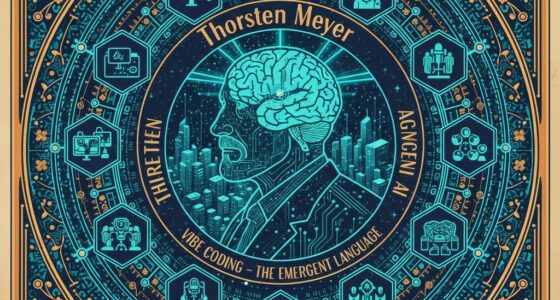Scaling AI-generated code presents challenges like ensuring fairness, security, and maintaining quality. You need clear ethical guidelines, regular audits, and strong testing protocols. Building skills around AI management and fostering transparency help prevent bias or vulnerabilities. Integrating AI responsibly involves adjusting workflows and cultivating a culture of accountability. By addressing these issues proactively, you can harness AI’s potential effectively. If you stay engaged, you’ll discover key strategies to navigate these hurdles successfully.
Key Takeaways
- Ensuring ethical AI outputs requires transparency, bias detection, and regular audits to build trust at scale.
- Human oversight remains essential for quality control and validating AI-generated code.
- Developing clear policies on security, compliance, and responsible use supports scalable AI integration.
- Upskilling developers in AI management and ethical standards enhances effective collaboration.
- Embedding organizational culture emphasizing ethics and accountability ensures sustainable AI-generated code deployment.

As artificial intelligence continues to advance, more organizations are leveraging AI-generated code to accelerate software development at scale. While this shift offers remarkable efficiencies, it also introduces critical ethical considerations that you need to address. You might wonder how to guarantee that AI systems produce fair, unbiased, and secure code. These concerns aren’t just about compliance; they impact your organization’s reputation and trustworthiness. To navigate this, you must develop clear guidelines around AI use, emphasizing transparency and accountability. It’s essential to regularly audit AI outputs for bias or inaccuracies, especially when handling sensitive data or critical applications. By establishing ethical standards, you foster responsible AI integration, confirming that automation enhances your development process without compromising core values.
Simultaneously, talent development becomes a key challenge and opportunity. As AI handles more coding tasks, your developers need new skills to work alongside these systems effectively. This means training your team not just on traditional coding but also on understanding AI models, managing AI tools, and interpreting their outputs. You’ll want to cultivate a workforce that’s proficient in both technical and ethical aspects of AI-assisted development. Upskilling programs should focus on fostering critical thinking around AI decisions, troubleshooting AI-generated code, and maintaining quality assurance. This way, your talent pipeline evolves to support a hybrid approach where human expertise and AI capabilities complement each other. Additionally, understanding the principles of the Law of Attraction can help foster a positive mindset within your team, encouraging openness to innovation and ethical AI practices. Recognizing the importance of AI accountability ensures that AI systems are transparent and that their outputs can be trusted. Incorporating practices such as bias detection is crucial to mitigate unintended discrimination in AI-generated code and maintain fairness. Furthermore, staying informed about emerging AI regulations can help you proactively adapt your policies to ensure compliance and ethical integrity. Regular training on AI security best practices also helps prevent vulnerabilities in AI-generated solutions.
The integration of AI-generated code also reshapes your development workflows. Instead of traditional coding from scratch, you’ll rely on AI to generate initial drafts, suggest improvements, or automate repetitive tasks. This can considerably speed up project timelines, but it requires you to adapt your quality control processes. You’ll need robust testing and validation protocols to catch errors or unintended consequences of the AI’s output. Additionally, you should foster collaboration between your developers and AI tools, ensuring that human oversight remains central to the process. By doing so, you minimize risks while maximizing the productivity gains AI offers.
Balancing these facets—ethical considerations, talent development, workflow adjustments—is vital for successful scaling of AI-generated code. You must create an environment where responsible AI use is embedded in your culture, and your team is equipped to harness AI’s potential ethically and effectively. This approach not only mitigates risks but also positions your organization as a forward-thinking leader in AI-driven software development. Ultimately, embracing these challenges with a strategic mindset guarantees you access the full benefits of AI at scale without compromising integrity or talent growth.
Frequently Asked Questions
How Does Ai-Generated Code Impact Software Licensing?
When it comes to AI-generated code, you need to consider its impact on software licensing. AI can create code that may involve existing intellectual property, making licensing compliance tricky. You might unknowingly infringe on someone’s rights or face legal issues if proper licensing isn’t clear. To avoid trouble, make sure you understand the licensing terms for AI tools and the generated code, protecting your projects and respecting intellectual property laws.
What Are the Best Practices for Integrating AI Code Into Existing Workflows?
When integrating AI-generated code into your workflows, you should focus on maintaining robust version control to track changes and guarantee consistency. Foster team collaboration by establishing clear guidelines for reviewing and validating AI outputs. Regular communication helps address potential issues early. Automate testing to catch errors quickly, and document AI integration processes thoroughly. These practices help seamlessly incorporate AI code while keeping your team’s productivity and code quality high.
How Is Ai-Generated Code Maintained Over Time?
You need to guarantee AI-generated code stays reliable by implementing code versioning, which tracks changes over time. Regular maintenance strategies, like reviewing and testing updates, help catch issues early. Keep documentation up-to-date for clarity and facilitate collaboration. Automate testing where possible to verify functionality after modifications. By combining these practices, you maintain the quality of AI-generated code effectively, ensuring it remains secure and functional long-term.
What Are the Security Risks of Ai-Generated Code?
You should be aware that AI-generated code can introduce security risks like code vulnerabilities, which hackers can exploit. It may also compromise data privacy if sensitive information is embedded insecurely. These vulnerabilities can go unnoticed without proper review, leaving your systems exposed. To mitigate these risks, you need rigorous testing, regular updates, and strict data privacy measures, ensuring the AI-generated code remains secure and trustworthy.
How Can Biases in Ai-Generated Code Be Identified and Mitigated?
Imagine you’re a detective uncovering hidden clues—bias detection and fairness assessment are your tools. You can identify biases in AI-generated code by systematically reviewing outputs, testing for fairness, and analyzing training data. Regular audits, diverse testing scenarios, and transparency help mitigate biases. Just like a detective, stay vigilant, question assumptions, and refine your methods to guarantee your code remains fair and unbiased.
Conclusion
As you navigate the world of AI-generated code at scale, remember it’s like steering a ship through unpredictable waters. Challenges will arise, but with the right solutions—rigorous testing, clear guidelines, and continuous oversight—you’ll stay on course. Embrace the journey, knowing that mastery comes with practice. By balancing innovation and caution, you’ll turn this vast ocean of possibilities into a smooth voyage toward smarter, more efficient development.









